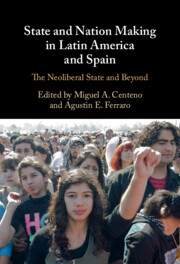Book contents
- State and Nation Making in Latin America and Spain
- State and Nation Making in Latin America and Spain
- Copyright page
- Dedication
- Contents
- Notes on Contributors
- Preface
- Part I Introduction
- Part II Economic and Territorial Power
- Part III Infrastructural Power: Reform Strategies
- 6 Two Roads of Neoliberal Reform in Higher Education
- 7 Reinvented Governments in Latin America
- 8 The Devil Hides in the Details
- 9 Neoliberal Reform of Transport Institutions in Brazil, Argentina, and Chile
- 10 The End Game of Social Policy in a Context of Enduring Inequalities
- Part IV Symbolic Power: Identities and Social Protest
- Part V Conclusions
- Index
- References
7 - Reinvented Governments in Latin America
Reform Waves and Diverging Outcomes
from Part III - Infrastructural Power: Reform Strategies
Published online by Cambridge University Press: 03 August 2023
- State and Nation Making in Latin America and Spain
- State and Nation Making in Latin America and Spain
- Copyright page
- Dedication
- Contents
- Notes on Contributors
- Preface
- Part I Introduction
- Part II Economic and Territorial Power
- Part III Infrastructural Power: Reform Strategies
- 6 Two Roads of Neoliberal Reform in Higher Education
- 7 Reinvented Governments in Latin America
- 8 The Devil Hides in the Details
- 9 Neoliberal Reform of Transport Institutions in Brazil, Argentina, and Chile
- 10 The End Game of Social Policy in a Context of Enduring Inequalities
- Part IV Symbolic Power: Identities and Social Protest
- Part V Conclusions
- Index
- References
Summary
This chapter provides a historical institutionalist interpretation of first- and second-generation administrative reforms in Latin America during the 1990s, building on the experiences of Argentina, Brazil, Chile, and Peru. Although path dependence partly explains why Brazil and Chile were able to secure bureaucratic autonomy during the first wave and retain the administrative capacity to implement the second wave of reforms successfully, the contrasting experiences of Argentina and Brazil illustrate how similarly profound critical junctures led to different outcomes depending on a contingent constellation of political factors. The chapter also illustrates how the concept of sequencing is key to explain the success of second-generation reforms. In Argentina and Peru, where first-generation reforms were profound, administrative autonomy was undermined, and the capacity to implement the recommendations of the second wave was severely hampered. Overall, the chapter illustrates how the field of public administration could benefit from the incorporation of concepts such as bureaucratic autonomy and capacity and theoretical constructs such as path dependence, critical junctures, contingency, forking, sequencing, and others, which are central to the study of the state in the historical institutionalist tradition.
- Type
- Chapter
- Information
- State and Nation Making in Latin America and SpainThe Neoliberal State and Beyond, pp. 243 - 268Publisher: Cambridge University PressPrint publication year: 2023



